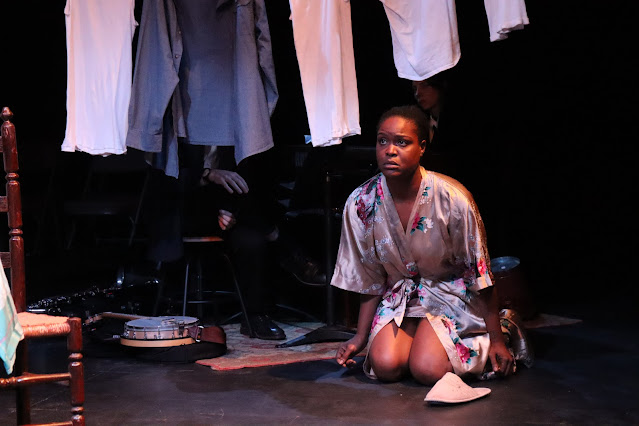The Transfiguration of Benjamin Banneker
Conceived, designed, and directed by Theodora Skipitares
66 E 4th St., Manhattan, NYC
January 23-February 2, 2020
 |
| Giant Banneker head by Theodora Skipitares. Photo by Theo Cote. |
There are not many shows in which the audience is played into the theater by a drum corps, but then again, there aren't many people like the subject of the play
The Transfiguration of Benjamin Banneker. Benjamin Banneker, who lived from 1731 to 1806 in Maryland, was a Black astronomer, mathematician, and writer who, among other accomplishments, developed the idea that distant stars signified other solar systems. Created and directed by Theodora Skipitares,
The Transfiguration invigoratingly employs an array of storytelling techniques, including narrative, music, dance, and puppetry, to bring much deserved attention to Banneker's life and legacy, as well as to draw parallels with the achievements and struggles of a pair of twentieth-century Black pioneers.
After an opening that touches on the infinitude of the universe, the play narrows things down a bit to focus on Banneker's life, beginning with his ancestry: a white English grandmother who is sentenced to transportation to the colonies and indentured servitude and a grandfather who hails from Mali and was initially owned by his grandmother; followed by a mother who marries another formerly enslaved man, this one from Guinea. As the production circulates among episodes from Banneker's life—his self-taught construction of a clock, his accuracy in eclipse prediction, his correspondence with Thomas Jefferson (voiced by Tom Walker), and more—Banneker, given voice by a fantastic Reginald L. Barnes, is sometimes a more traditional puppet and sometimes a giant floating head trailing lighted strands that might simultaneously represent his thoughts, the cosmos, and his connections to others, then and now. Candles that appear in the silhouette cutouts that present his family tree hold a similarly multivalent symbolic power, calling to mind spirits, sparks of passion or intellect, and also stars—all meanings that remain in play in the positioning of one at the heart of the Banneker-as-puppet.
 |
| Chris Ignacio and Banneker puppet. Photo by Theo Cote. |
The transfiguration of the show's title could be seen as referring not only to Banneker as an individual but also to how the outlines of his story—the racist skepticism and hostility, including threats of violence to his person and the burglary of his home, the way that his scientific achievements are situated as evidence in arguments over racial potential—are transformed into new but similar stories. In the second half of the play, we meet pilot Ed Dwight, also voiced by Barnes, who was the first Black candidate for the astronaut program in the United States. Dwight later became an artist, and among his works is, in a symbolically resonant link, a memorial to Benjamin Banneker that never came to fruition. We also, more briefly, spend some time with Nichelle Nichols, Lt. Uhura of Star Trek (voiced by Alexandria Joesica Smalls), whose voyage into space was no less significant for being fictional.
 |
| Giant heads by Theodora Skipitares. Banneker chorus. Photo by Theo Cote. |
The Transfiguration of Benjamin Banneker serves up a banquet for the senses. It tells its stories and explores it themes through narration and direct quotation, through animation, scrims, and silhouettes (perhaps recalling at one point the work of Kara Walker), through puppets large and small. Dancers—all young people of color and most students at Benjamin Banneker Academy high school in Brooklyn—variously perform to African-influenced drumming, to evoke the movement of Banneker's clock, wearing giant heads, or wrapped in colored light. An astronaut floats overhead, and planets speak. And there is almost always music: some recorded and some live, from electronic beats under early dialogue to banjo to more ethereal, organ-like tones during the section about Banneker's funeral, but most strikingly via members of the
Soul Tigers, a Brooklyn-based non-profit, after-school marching band and music education program. The Soul Tigers bring a singular energy to the production, not least when two featured drummers, a snare and a bass, conduct a lightly pantomimed face-off between Banneker and Jefferson. Throughout, while the action, methods, and players onstage are always changing, the overall rhythm of ebbs and flows work towards a cohesive whole.
 |
| Banneker head with Soul Tigers in finale. Photo by Theo Cote. |
In the play, comments from Dwight and astronaut Frank Borman echo one another in describing how their experiences brought home to them the insignificance of the Earth and its artificial boundaries. Until the rest of the world comes to this kind of realization, the type of historical recovery and celebration that the rousing and reflective
Transfiguration of Benjamin Banneker performs will remain vital.
You can support The Transfiguration of Benjamin Banneker at the play's
Indiegogo page.
-John R. Ziegler and Leah Richards







Comments
Post a Comment